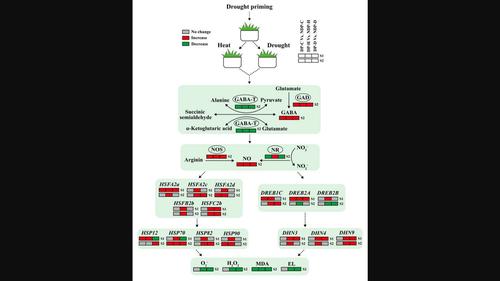当前位置:
X-MOL 学术
›
Plant Biol.
›
论文详情
Our official English website, www.x-mol.net, welcomes your feedback! (Note: you will need to create a separate account there.)
Drought priming‐induced stress memory improves subsequent drought or heat tolerance via activation of γ‐aminobutyric acid‐regulated pathways in creeping bentgrass
Plant Biology ( IF 3.9 ) Pub Date : 2024-03-21 , DOI: 10.1111/plb.13636 Y. Yuan 1 , M. Tan 1 , M. Zhou 1 , M. J. Hassan 1 , L. Lin 1 , J. Lin 1 , Y. Zhang 1 , Z. Li 1
Recurrent drought can induce stress memory in plants to induce tolerance to subsequent stress, such as high temperature or drought. Drought priming (DP) is an effective approach to improve tolerance to various stresses; however, the potential mechanism of DP‐induced stress memory has not been fully resoved. We examined DP‐regulated subsequent drought tolerance or thermotolerance associated with changes in physiological responses, GABA and NO metabolism, heat shock factor (HSF) and dehydrin (DHN) pathways in perennial creeping bentgrass. Plants can recover after two cycle of DP, and DP‐treated plants had significantly higher tolerance to subsequent drought or heat stress, with higher leaf RWC, Chl content, photochemical efficiency, and cell membrane stability. DP significantly alleviated oxidative damage through enhancing total antioxidant capacity in response to subsequent drought or heat stress. Endogenous GABA was significantly increased by DP through activating glutamic acid decarboxylase activity and inhibiting GABA transaminase activity. DP also enhanced accumulation of NO, depending on NOS activity, under subsequent drought or heat stress. Transcript levels of multiple transcription factors, heat shock proteins, and DHNs in the HSF and DHN pathways were up‐regulated by DP under drought or heat stress, but there were differences between DP‐regulated heat tolerance and drought tolerance in these pathways. The findings indicate that under recurrent moderate drought, DP improves subsequent tolerance to drought or heat stress in relation to GABA‐regulated pathways, providing new insight into understanding of the role of stress memory in plant adaptation to complex environmental stresses.
中文翻译:

干旱引发诱导的应激记忆通过激活匍匐翦股颖中的γ-氨基丁酸调节途径来改善随后的干旱或耐热性
反复的干旱可以诱导植物的逆境记忆,从而诱导对后续逆境(例如高温或干旱)的耐受性。干旱启动(DP)是提高对各种胁迫的耐受性的有效方法;然而,DP诱发压力记忆的潜在机制尚未完全阐明。 我们研究了多年生匍匐翦股颖中与生理反应、GABA 和 NO 代谢、热休克因子 (HSF) 和脱水素 (DHN) 途径变化相关的 DP 调节的后续耐旱性或耐热性。 两个DP周期后植物即可恢复,且DP处理的植物对随后的干旱或热胁迫具有显着更高的耐受性,具有更高的叶片RWC、叶绿素含量、光化学效率和细胞膜稳定性。 DP 通过增强总抗氧化能力来应对随后的干旱或热应激,从而显着减轻氧化损伤。 DP通过激活谷氨酸脱羧酶活性并抑制GABA转氨酶活性显着增加内源GABA。在随后的干旱或热胁迫下,DP 还可增强 NO 的积累,具体取决于 NOS 活性。在干旱或热胁迫下,HSF和DHN途径中的多种转录因子、热休克蛋白和DHN的转录水平被DP上调,但这些途径中DP调节的耐热性和耐旱性之间存在差异。 研究结果表明,在反复发生的中度干旱下,DP 提高了与 GABA 调节途径相关的随后对干旱或热胁迫的耐受性,为理解胁迫记忆在植物适应复杂环境胁迫中的作用提供了新的见解。
更新日期:2024-03-21
Plant Biology ( IF 3.9 ) Pub Date : 2024-03-21 , DOI: 10.1111/plb.13636 Y. Yuan 1 , M. Tan 1 , M. Zhou 1 , M. J. Hassan 1 , L. Lin 1 , J. Lin 1 , Y. Zhang 1 , Z. Li 1
Affiliation

|
中文翻译:

干旱引发诱导的应激记忆通过激活匍匐翦股颖中的γ-氨基丁酸调节途径来改善随后的干旱或耐热性



























 京公网安备 11010802027423号
京公网安备 11010802027423号